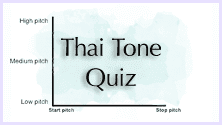อ่าน : Àan = to read
Question & Answer :
คุณอ่านภาษาไทยได้ไหม : (Koon) Àan (Paa-săa) Thai Dâi~Măi? = Can you read Thai language?
Positive Answer : Dâi Krúb/Ká = Yes I can
Negative Answer : Mâi Dâi Krúb/Ká = No I can not
Language points :
คุณ : Koon means ‘You’. It’s a polite and common personal pronoun used to address the person who you are talking to (except young child)
ภาษา : Paa-săa = ‘Language’
ได้ : Dâi = ‘can’ ; ‘able to’ ; ‘possible to’ (used at the end of a statement when you want to indicate the ability or possibility of what ever you just said)
ไหม : Măi? = ‘A question word’ used at the end of a sentence when you want to know a ‘positive’ or ‘negative’ answer. It is used after a statement to change it into a question. Măi? can be compared to ‘Do…?, Would…?, Are…?, Is…?, Am…?’ in English.
ได้ไหม : Dâi~Măi? = [Question] ‘Can …… ?’ ; ‘Could …… ?’ (used at the end of a statement when you want to ask the ability or possibility of what ever you just said. It’s a compound question word combined from ‘Dâi = can; able to; possible to’ and Măi? = Yes/No question word.)
ครับ : Krúb (used by males) / ค่ะ : Kâ (used by females) = [Particle] used when finishing a word, clause, statement, question sentence, etc. to show politeness or speak politely. For example, Sà-wùd-dee means Hello but Sà-wùd-dee Kâ is more polite. [Exclamation word] ‘Yes’ used in two situations; 1. used as a polite response to someone addressing you. 2. used to politely acknowledge or encourage someone to continue speaking.


